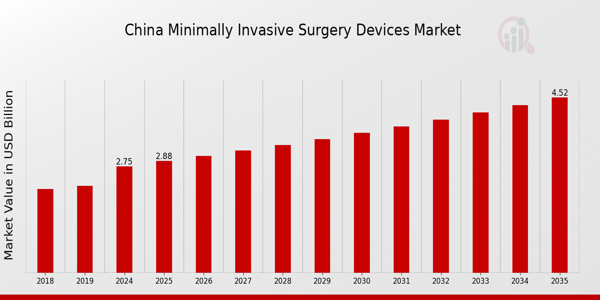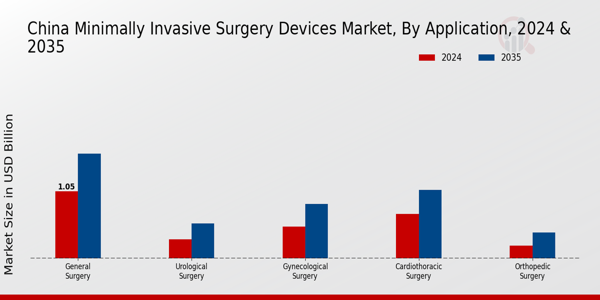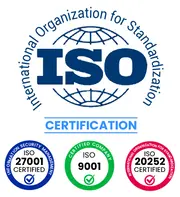China Minimally Invasive Surgery Devices Market Overview
As per MRFR analysis, the China Minimally Invasive Surgery Devices Market Size was estimated at 2.56 (USD Billion) in 2023. The China Minimally Invasive Surgery Devices Market Industry is expected to grow from 2.75(USD Billion) in 2024 to 4.52 (USD Billion) by 2035. The China Minimally Invasive Surgery Devices Market CAGR (growth rate) is expected to be around 4.621% during the forecast period (2025 - 2035).
Key China Minimally Invasive Surgery Devices Market Trends Highlighted
The China Minimally Invasive Surgery Devices Market is experiencing rapid growth fueled by several key market drivers. The increasing prevalence of chronic diseases such as cardiovascular disorders, diabetes, and obesity is pushing the demand for surgical procedures that require minimally invasive techniques. Additionally, the aging population in China is further heightening the need for surgical interventions that offer lower risks and shorter recovery times compared to traditional methods. A significant government focus on enhancing healthcare infrastructure and promoting advanced medical technologies also plays a vital role in driving the market forward.
Opportunities in the China market can be captured by expanding access to advanced surgical devices across various regions, especially in rural and underserved areas where healthcare facilities may be limited. Investment in local manufacturing and partnerships with global medical device companies can facilitate the adoption of innovative, minimally invasive technologies. Moreover, there is potential for growth in the area of robotic-assisted surgeries, as hospitals seek to improve precision and outcomes while reducing human error.
Trends in recent times show a shift towards incorporating digital technologies in minimally invasive surgeries, such as augmented reality and artificial intelligence, for enhanced surgical planning and training.Collaborations between hospitals and technology firms are becoming more common, aiming to improve surgical techniques and patient outcomes. The increasing focus on patient-centric care is also influencing the development of new devices that prioritize comfort and reduce recovery time. With a concerted push from the government and the healthcare sector, China is poised to remain a leading market for minimally invasive surgery devices, adapting to dynamic healthcare demands and technological advancements.

Source: Primary Research, Secondary Research, Market Research Future Database and Analyst Review
China, Minimally Invasive Surgery Devices Market Drivers
Increasing Prevalence of Chronic Diseases
Chronic conditions, including obesity, diabetes, and cardiovascular disease, are becoming more common in China, which has a big impact on the market for minimally invasive surgical devices. Cardiovascular disorders caused about 40% of all fatalities in 2020, according to China's National Health Commission, underscoring a serious health emergency. According to the China Diabetes Society, the prevalence of diabetes has also increased, impacting around 11% of adults. Due to their shorter recovery periods and shorter hospital stays, minimally invasive surgical techniques are becoming more and more popular in clinical settings as a result of the growing health burden.
The market may increase significantly as a result of the aggressive promotion of the advantages of minimally invasive therapies by prominent medical associations like the Chinese Society of Interventional Radiology.
Technological Advancements in Surgical Equipment
The China Minimally Invasive Surgery Devices Market Industry is being propelled by rapid advancements in surgical technologies. Innovations such as robotic-assisted surgery, enhanced imaging techniques, and advanced laparoscopic instruments are improving the safety and effectiveness of minimally invasive procedures. The Ministry of Science and Technology in China has allocated substantial funding for Research and Development in this area, reportedly exceeding 50 billion USD in the past five years. As these technologies become more sophisticated and widely accessible, healthcare facilities are increasingly adopting minimally invasive techniques.
The rise of multinational corporations like Siemens Healthineers and Medtronic in China is indicative of the competitive landscape, fostering further innovations that could significantly enhance surgical outcomes and market growth.
Government Initiatives to Promote Healthcare
The Chinese government has been proactive in promoting healthcare reforms that favor minimally invasive surgical methods. The State Council of China issued a major health initiative aimed at expanding access to advanced surgical procedures and improving overall healthcare quality. This policy aims to reduce the burden on traditional surgical systems by encouraging the adoption of minimally invasive techniques, ultimately improving patient outcomes.Funding allocations from the National Health Commission have increased, with a target to allocate over 30 billion USD to enhance surgical capabilities by 2025.
Such government initiatives not only boost the acceptance of minimally invasive surgery but also resonate well with hospitals and clinics across the nation, thereby promoting substantial growth in the China Minimally Invasive Surgery Devices Market Industry.
Rising Geriatric Population
China is experiencing a significant demographic shift, with an aging population projected to reach over 487 million by 2050, as per the National Bureau of Statistics of China. This demographic change is catalyzing demand for minimally invasive surgeries, as older adults generally require surgical interventions more frequently due to age-related health issues.
The World Health Organization indicates that older adults benefit greatly from minimally invasive procedures, as these techniques tend to result in less trauma and quicker recovery.Hospitals and healthcare providers are thus focusing on expanding their capabilities for minimally invasive procedures to cater to this growing segment of the population. Organizations like the Chinese Geriatric Society are raising awareness about the importance of these procedures for elderly care, further driving the growth of the China Minimally Invasive Surgery Devices Market Industry.
China Minimally Invasive Surgery Devices Market Segment Insights
Minimally Invasive Surgery Devices Market Application Insights
The Application segment of the China Minimally Invasive Surgery Devices Market covers a wide range of surgical practices, reflecting the diverse needs and advancements in healthcare across the region. General Surgery leads this segment, addressing numerous surgical conditions with techniques that facilitate quicker recovery times and less postoperative pain for patients. In an era where healthcare efficiency is paramount, the significance of Cardiothoracic Surgery cannot be understated as it employs minimally invasive methods to address complex conditions of the heart and lungs, reducing complications and improving recovery outcomes.
Gynecological Surgery also plays a crucial role in this market, focusing on women's health issues with minimally invasive approaches that allow for enhanced precision and better healing rates, thereby elevating the patient's overall experience. Urological Surgery is gaining traction as well, driven by technological innovations that minimize invasiveness while ensuring maximum effectiveness in treating urinary tract disorders. Orthopedic Surgery contributes to the growth of the market through advanced techniques that allow surgeons to perform complex procedures like joint replacements or spinal surgeries with decreased trauma to the body.
As such, the Application segment of the China Minimally Invasive Surgery Devices Market demonstrates not only the importance of each subsection but also highlights the overarching trend towards patient-centric care, improved surgical outcomes, and the pressing need for innovations that address various healthcare challenges in the region. The adoption of these devices is fueled by the increasing prevalence of chronic diseases, an aging population, and a rising emphasis on advanced surgical techniques that promise quicker recoveries and less invasive procedures for patients.
Consequently, the China Minimally Invasive Surgery Devices Market is poised for impressive growth, with each segment playing a vital role in shaping the future of surgical practices across the nation. The collective efforts towards research and development, particularly in these application areas, indicate a vibrant market dynamic that continuously adapts to meet the demands of healthcare providers and patients alike, ensuring that minimally invasive surgery remains at the forefront of modern medical practices.

Source: Primary Research, Secondary Research, Market Research Future Database and Analyst Review
Minimally Invasive Surgery Devices Market Product Type Insights
The China Minimally Invasive Surgery Devices Market is characterized by a diverse range of product types that cater to various surgical needs. Among these, endoscopes are crucial for enabling doctors to visualize internal organs without large incisions, thus enhancing patient recovery times and reducing hospital stays. Robotic surgery systems represent a significant technological advancement, providing surgeons with enhanced precision and control during delicate procedures and contributing to better patient outcomes. Laparoscopic surgical instruments remain popular for their effectiveness in a wide variety of procedures, promoting less trauma to patients compared to traditional methods.
Visualization systems, integral to minimally invasive surgery, improve clarity for surgeons, ensuring informed decision-making. Access devices play a vital role in the setup of minimally invasive procedures, facilitating the introduction of various surgical instruments through smaller incisions. As the trend toward less invasive techniques grows, these product types are expected to gain prominence, driven by advancements in technology and increasing demand for efficient surgical solutions in China. Each of these segments showcases the dynamic evolution within the China Minimally Invasive Surgery Devices Market, highlighting opportunities for growth and innovation in surgical methodologies.
Minimally Invasive Surgery Devices Market End Use Insights
The China Minimally Invasive Surgery Devices Market demonstrates substantial opportunities across various end use segments, notably in hospitals, ambulatory surgical centers, and specialty clinics. Hospitals usually account for the majority of the market share due to their extensive surgical services and advanced technology adoption, facilitating a wide application of minimally invasive procedures. Ambulatory surgical centers have gained traction, offering cost-effective solutions and shorter recovery times, making them popular among patients seeking outpatient procedures.Specialty clinics are rapidly growing as they focus on specific surgical areas, fostering innovations and specialized treatments tailored to patient needs.
This diversification in end use not only showcases the adaptability of surgical devices but also reflects shifting patient preferences towards less invasive options, which are linked to faster recovery and reduced hospital stays. The rising demand for minimally invasive surgeries in China, driven by factors such as an aging population, increasing prevalence of chronic diseases, and heightened healthcare awareness, is likely to contribute to the sustained growth of these end use segments in the coming years.
Minimally Invasive Surgery Devices Market Technology Insights
The Technology segment of the China Minimally Invasive Surgery Devices Market exhibits notable advancements and growth potential through various methods such as Video-Assisted Thoracoscopic Surgery, Transcatheter Aortic Valve Replacement, and Natural Orifice Transluminal Endoscopic Surgery. Video-Assisted Thoracoscopic Surgery is significant as it allows for less invasive procedures in thoracic surgery, improving patient recovery times and reducing hospital stays. Transcatheter Aortic Valve Replacement has gained traction due to its critical role in treating severe aortic stenosis in elderly patients, offering a less invasive alternative compared to traditional surgery, which aligns with China's aging population.
Moreover, Natural Orifice Transluminal Endoscopic Surgery is emerging as a cutting-edge technique, as it enables surgeries to be performed through natural orifices, minimizing scarring and enhancing recovery. This segment's growth is driven by trends towards enhanced surgical precision, patient safety, and faster recovery times, indicative of a shift in healthcare preferences towards more sophisticated and minimally invasive solutions. The increasing adoption of these technologies reflects a broader effort within China's healthcare system to provide efficient and effective surgical interventions, enhancing overall patient outcomes significantly..
China Minimally Invasive Surgery Devices Market Key Players and Competitive Insights
The China Minimally Invasive Surgery Devices Market has been witnessing significant growth due to increasing demand for advanced surgical options that reduce recovery time and minimize patient trauma. This shift toward minimally invasive techniques is driven by a combination of factors, including rising incidences of chronic diseases, a growing elderly population, and advancements in technology that allow for more precise surgical interventions. The competitive landscape in this market is characterized by a mix of global and local players, each striving to innovate and expand their market share. Key players focus on developing new devices and technologies to enhance surgical outcomes.
Strategic partnerships, mergers, and acquisitions are prevalent as companies aim to strengthen their product portfolios and establish a robust distribution network across China.Zimmer Biomet, a prominent player in the China Minimally Invasive Surgery Devices Market, has made notable strides in establishing a strong presence in the region. The company is renowned for its innovative orthopedic and surgical solutions that cater to the diverse needs of healthcare providers and patients. With a comprehensive range of products that emphasize technology and patient safety, Zimmer Biomet leverages its expertise to drive growth in minimally invasive procedures.
The company's strengths lie in its extensive research and development efforts, enabling it to introduce cutting-edge technologies tailored to local market dynamics while also ensuring compliance with regulatory standards. This strategic focus on innovation allows Zimmer Biomet to maintain a competitive edge, making significant contributions to the overall development of minimally invasive surgery in China.Intuitive Surgical has emerged as a leader in the China Minimally Invasive Surgery Devices Market, largely due to its flagship product, the da Vinci Surgical System.
This robotic-assisted surgical platform has revolutionized the landscape of minimally invasive surgery by offering precision, control, and improved visibility during complex procedures. Intuitive Surgical's market presence in China has been bolstered by strong demand for robotic surgery across various medical specialties. The company's strengths include a robust training and support infrastructure for healthcare professionals, ensuring they are well-equipped to utilize its technology effectively. Additionally, Intuitive Surgical has engaged in strategic partnerships and collaborations, enhancing its distribution network and expanding its reach within the Chinese healthcare market.
Through continual innovation and an unwavering commitment to improving surgical outcomes, Intuitive Surgical remains at the forefront of minimally invasive surgery in China, shaping the future of surgical practices in the region.
Key Companies in the China Minimally Invasive Surgery Devices Market Include
- Zimmer Biomet
- Intuitive Surgical
- Hernon Manufacturing
- Microline Surgical
- Olympus
- Medtronic
- Boston Scientific
- Acelity
- Cook Medical
- Smith & Nephew
- Terumo
- Johnson & Johnson
- B. Braun Melsungen
- Stryker
- ConMed
China Minimally Invasive Surgery Devices Market Industry Developments
Recent developments in the China Minimally Invasive Surgery Devices Market have been noteworthy, marked by significant growth in the value and adoption of minimally invasive technologies. In September 2023, Medtronic announced advancements in their robotic surgery systems tailored for the Chinese market, aiming to enhance surgical precision and patient outcomes. Olympus has also made strides with the introduction of innovative endoscopic systems that align with China's increasing emphasis on minimally invasive procedures. In the realm of mergers and acquisitions, Boston Scientific completed its acquisition of a local competitor in August 2023, broadening its footprint within the region.
The burgeoning demand has led to considerable investments from major players like Stryker and Johnson and Johnson who are actively expanding their product lines in line with the growing healthcare needs in China. In the past two years, the market has seen ongoing research collaborations and partnerships, particularly focusing on enhancing technology and innovation in surgical procedures, ensuring a robust environment for the continued evolution of minimally invasive surgery across China.
China Minimally Invasive Surgery Devices Market Segmentation Insights
Minimally Invasive Surgery Devices Market Application Outlook
- General Surgery
- Cardiothoracic Surgery
- Gynecological Surgery
- Urological Surgery
- Orthopedic Surgery
Minimally Invasive Surgery Devices Market Product Type Outlook
- Endoscopes
- Robotic Surgery Systems
- Laparoscopic Surgical Instruments
- Visualization Systems
- Access Devices
Minimally Invasive Surgery Devices Market End Use Outlook
- Hospitals
- Ambulatory Surgical Centers
- Specialty Clinics
Minimally Invasive Surgery Devices Market Technology Outlook
- Video-Assisted Thoracoscopic Surgery
- Transcatheter Aortic Valve Replacement
- Natural Orifice Transluminal Endoscopic Surgery
| Report Attribute/Metric Source: |
Details |
| MARKET SIZE 2023 |
2.56(USD Billion) |
| MARKET SIZE 2024 |
2.75(USD Billion) |
| MARKET SIZE 2035 |
4.52(USD Billion) |
| COMPOUND ANNUAL GROWTH RATE (CAGR) |
4.621% (2025 - 2035) |
| REPORT COVERAGE |
Revenue Forecast, Competitive Landscape, Growth Factors, and Trends |
| BASE YEAR |
2024 |
| MARKET FORECAST PERIOD |
2025 - 2035 |
| HISTORICAL DATA |
2019 - 2024 |
| MARKET FORECAST UNITS |
USD Billion |
| KEY COMPANIES PROFILED |
Zimmer Biomet, Intuitive Surgical, Hernon Manufacturing, Microline Surgical, Olympus, Medtronic, Boston Scientific, Acelity, Cook Medical, Smith & Nephew, Terumo, Johnson & Johnson, B. Braun Melsungen, Stryker, ConMed |
| SEGMENTS COVERED |
Application, Product Type, End Use, Technology |
| KEY MARKET OPPORTUNITIES |
Growth in outpatient procedures, Rising geriatric population, Advancements in robotic surgery, Increased prevalence of chronic diseases, Expansion of healthcare infrastructure |
| KEY MARKET DYNAMICS |
growing elderly population, increasing healthcare spending, technological advancements, rising prevalence of chronic diseases, demand for faster recovery options |
| COUNTRIES COVERED |
China |
Frequently Asked Questions (FAQ):
The projected market size for the China Minimally Invasive Surgery Devices Market in 2024 is 2.75 billion USD.
The market is expected to reach 4.52 billion USD by the year 2035.
The expected CAGR for the China Minimally Invasive Surgery Devices Market from 2025 to 2035 is 4.621%.
The General Surgery application segment holds the largest market share, valued at 1.05 billion USD in 2024.
The market size for the Cardiothoracic Surgery application is valued at 0.7 billion USD in 2024.
Major players in the market include Medtronic, Boston Scientific, Johnson & Johnson, and Stryker, among others.
The Gynecological Surgery segment is projected to reach 0.85 billion USD by 2035.
Increased demand for advanced surgical techniques and cost-efficiency are key drivers of market growth.
The Urological Surgery application market is expected to grow from 0.3 billion USD in 2024 to 0.55 billion USD in 2035.
Challenges include regulatory hurdles and the need for skilled professionals to operate advanced devices.
















